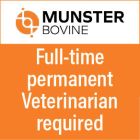Early diagnosis of BRD using clinical respiratory signs and thoracic ultrasonography
The impact of bovine respiratory disease is significant – economically and in terms of animal welfare. Inmaculada Cuevas-Gómez, Mark McGee and Bernadette Earley all from Teagasc, Animal & Grassland Research and Innovation Centre discuss early diagnosis of the disease using clinical respiratory signs and thoracic ultrasonography
Bovine respiratory disease (BRD) is a disease of multifactorial aetiology affecting cattle of all ages. The multifactorial syndrome results from a complex interaction between infectious agents (bacteria, viruses), host immune status and external stressors (eg. weaning, transport, changes in diet and/or the housing environment). It is the most prevalent disease of dairy calves and recently-weaned beef calves in Ireland, accounting for 34.3% of deaths in calves between one and five months old (All-island Animal Disease Surveillance Report 2019, [Murray et al, 2017]). The economic impact of BRD is significant and it poses a major challenge to efficient bovine livestock production and welfare, as well as indirect economic losses related to reduced animal growth and carcase weight (Delabouglise et al, 2017).
Clinical diagnosis of BRD
Evaluation of clinical respiratory signs (cough, nasal discharge, eye discharge, ear drooping or elevated rectal temperature) is widely used at farm level for BRD diagnosis. Different respiratory scoring charts have been developed, especially for using in pre-weaned calves. These BRD scoring systems are one way to standardise diagnosis that can be easily applied by stockpersons. The one most frequently applied, with some modifications, is the Wisconsin calf respiratory scoring chart (Table 1). This scoring system classifies rectal temperature, presence of cough, appearance of nasal and eye discharges, and ear position with scores ranging from 0 to 3 (from normal to very abnormal), and the sum of all scores of each clinical signs define the total clinical respiratory score.
Thoracic auscultation is also used as a fundamental part of the assessment of the ruminant respiratory tract in veterinary medicine. However, clinical respiratory signs and auscultation are poorly correlated with lung lesions and post-therapeutic prognosis (Buczinski et al, 2016; Cuevas-Gómez et al, 2020). Therefore, although these methods can be useful to detect, clinical BRD cases, sub-clinical BRD cases can go undetected.

Adapted from (McGuirk and Peek, 2014). 1Score ≥5 is indicative of pneumonia. 2Rectal temperature.
Table 1. Clinical respiratory scoring system developed in the University of Wisconsin.
Lung lesions detection:
thoracic ultrasonography
Thoracic ultrasonography (TUS) is a rapid, non-invasive, on-site diagnostic and prognostic tool for finding lung abnormalities (Ollivett and Buczinski, 2016). Detection of lung abnormalities ante-mortem using TUS has been strongly correlated with findings post-mortem using necropsy (Baruch et al, 2019). TUS has greater accuracy for BRD diagnosis compared to conventional methods such as auscultation or clinical scoring criteria (Buczinski et al, 2014). Furthermore, this methodology requires only minimal training and skills, and has good inter-rater agreement for the detection of lung lesions. Different abnormalities that can be detected using TUS are the presence of pleural fluid accumulation, abscesses, or lung consolidation.
Transrectal probes are already widely used by bovine veterinarians and are suitable for TUS. Large-size calves should be restrained in a chute to perform the technique, whereas restraining in a chute is not required for small-size calves. Clipping the hair of the thorax is usually not necessary though hair can be clipped for a better ultrasonography image. Isopropyl alcohol (70%) is used as the transducing agent and is applied using a spray bottle.
Maximal depth of the probe should be set between 8-10cm for calves of larger sizes and between 6-8cm for smaller calves. Both sides of the thorax should be evaluated. The probe should be placed in the intercostal spaces parallel to the ribs and moved from dorsal to ventral along the grain of the hair. The key for an accurate scanning lies on systematic evaluation, starting from the tenth intercostal space and moving cranially to the first intercostal space for the right lung and from the tenth intercostal space to the second intercostal space for the left lung. In small-size calves, access to the cranial thorax in the axillary region can be performed using transrectal probes. However, with large size calves, particularly when restrained in a chute, it is not possible to scan the first to third intercostal spaces, limiting the evaluation of the cranial lung lobes where lung lesions are more likely to be found. Nevertheless, lung lesions placed within the fourth, fifth, and sixth intercostal spaces have been associated with negative health outcomes in large-size calves (Abutarbush et al, 2012).
The ultrasonogram of a normal aerated lung is characterised by the presence of a bright hyperechoic line representing the pleura with several reverberation artefacts below it (Figure 1).

Figure 1. Ultrasonogram of a normal aeriated lung in weaned and pre-weaned calves. Thoracic ultrasounds performed using a 8MHz Wi-Fi linear transducer (Tecnoscan SR-1C, Imporvet, Spain) at a maximal depth of 8cm and gain of 60dB. ICM = intercostal muscles; P = pleura.
In the ultrasonograms of normal lungs, one or more hyperechoic lines, which perpendicularly arise from the pleura, can sometimes be visualised. The lines are also known as ‘comet tails’ and indicate pleural roughening (Figure 2).

Figure 2. Ultrasonogram of a normal aeriated lung with the visualisation of one comet tail. Comet tail =arrowhead;
P = pleura.
Lung consolidation (also referred to as lesions) appear in the ultrasonogram as a hypoechoic area of varying size that disrupts the reverberation artefacts and, sometimes, the pleura (Figure 3). The presence of lung consolidation in the lung lobe is also called lobular pneumonia.

Figure 3. Ultrasonograms with different sizes of consolidation (lobular pneumonia). Lung consolidation = star; P = pleura.
Lobar pneumonia is when the consolidation affects an entire lung lobe (Figure 4) and is visualised as a wide hypoechoic area with an ultrasonogram similar to that of liver parenchyma. Ramifications of the fluid bronchogram can be observed within the consolidated area.

Figure 4. Ultrasonogram of a consolidated lung lobe (lobar pneumonia). Ramification of the fluid bronchogram (arrow heads).
Other lesions that can be observed using TUS are emphysema and pleural effusion. Emphysema is visualised in the ultrasonogram as multiple hyperechoic bands that originate from the pleura which do not permit visualisation of the lung tissue below the pleura (Figure 5). Pleural effusion appears in the ultrasonogram as a disruption of the pleural line (Figure 6).

Figure 5. Ultrasonogram of lung emphysema.
P = pleura.
Using the combination of a clinical diagnostic system, such as clinical respiratory score charts, with TUS, BRD can be classified into subtypes:
- Upper respiratory infection: positive respiratory score and normal lung without lesions;
- Clinical BRD: positive respiratory score and lung with lesions; and
- Sub-clinical BRD: normal respiratory score and lung with lesions.

Figure 6: Pleural effusion. Pleural line does not follow a straight continuous line;
P = pleura.
The importance of an early and accurate BRD diagnosis
Early and accurate diagnosis of BRD are essential to guide more prudent use of antimicrobials, lower relapse rates and reduce animal mortality. Nonetheless, the diagnosis of BRD remains a challenge due to the lack of an ante-mortem ‘gold standard’ diagnostic method meaning that delayed and under-detection of BRD is a significant problem. Numerous methods such as auscultation, clinical respiratory score charts (including evaluation of nasal discharge, ear dropping, rectal temperature, cough and so on), and automated behaviour or temperature monitoring systems are used as diagnostic methods for BRD (Wolfger et al, 2015). However, these methods usually fail to detect lung lesions associated with BRD in animals of all ages, often resulting in a variable number of cases going undetected (Leruste et al, 2012). In Ireland, post-mortem examinations revealed a high prevalence of lung lesions (49%) which did not correspond with the records of calves showing clinical respiratory signs (17%) ante-mortem (Murray et al, 2017). Likewise, other authors have reported a much greater prevalence of lung lesions in cattle post-slaughter (43-68%) compared to corresponding ante-mortem clinical BRD records (17-23%) (Thompson et al, 2006; Blakebrough-Hall et al, 2020). Similarly, in North American dairy facilities, a greater percentage of lung lesions were detected by TUS (64%) in pre-weaned calves compared to their incidence (26%) of clinical BRD (Cramer and Ollivett, 2019).
Equally, recent studies performed at Teagasc Grange, showed that 18% (28/153) of recently-weaned suckler beef calves, as seen in Table 2 (Cuevas-Gómez et al, 2020) and 28% (15/53) of pre-weaned artificially-reared dairy calves (Cuevas-Gómez et al, unpublished) had lung lesions that were not detected using the Wisconsin calf respiratory scoring chart in the 28 and 30 days, respectively, post their arrival to the research centre.
Animals not showing a clinical presentation of BRD but having lung lesions are classified as sub-clinical BRD cases. This ‘silent’ presentation of BRD is important since economic losses are associated with sub-clinical BRD. For example, a study of feedlot beef cattle reported that animals with sub-clinical BRD, through the evaluation of lung lesions at slaughter, had 16kg lighter carcases and a 35% decrease in economic value at slaughter compared to their healthy counterparts (Blakebrough et al, 2020). Similarly, we reported that recently-weaned suckler beef calves with lung lesions, detected using TUS, had a reduction in live weight gain of 28.1% (0.23 v 0.32kg/day) during the first 65 days after housing compared to those without lung lesions (Cuevas-Gómez et al, 2020). In pre-weaned dairy heifers, lung lesions were associated with reduced live weight gain by 0.12kg/day (Cramer and Ollivett, 2019), a decrease of 525kg milk in their first lactation and a greater probability of being culled by the end of the first lactation (Teixeira et al, 2017). In our study, male dairy calves with severe lung lesions had reduced live weight gain by 0.1kg/day during the pre-weaning period compared to calves without lung lesions (Cuevas-Gómez et al, unpublished). The association of BRD with decreased ADG and increased mortality therefore has important implications for farm profitability.

1Clinical respiratory score from McGuirk and Peek (2014). Calves were considered CRS + when the score was ≥5. This score results from the sum of rectal temperature, ear, nasal, eye and cough scores which are evaluated from normal (0) to very abnormal (3).
2Thoracic ultrasonography.
Table 2. Distribution of 153 recently weaned beef calves according to clinical respiratory score and thoracic ultrasonography up to day 28 post-arrival.
Conclusion
BRD is a major challenge for the cattle industry with economic and welfare implications. The diagnosis of BRD using evaluation of clinical respiratory signs or auscultation is insufficient to detect sub-clinical BRD. The type, severity, and extent of BRD cannot always be determined by clinical examination alone and this may lead to misinterpretation of respiratory symptoms and ineffective therapy. The detection of sub-clinical BRD in cattle with lung lesions without showing clinical respiratory signs, can only be confirmed using TUS. The combination of clinical respiratory signs and thoracic ultrasonography provides a more accurate classification of BRD and sub-clinical BRD. Besides, thoracic ultrasonography is also a good technique for evaluating the prognosis of BRD and monitoring the efficacy of antibiotics.
References
References available on request.
Funding
This project is funded through the US-Ireland Department of Agriculture, Food and the Marine grant (Project number 2018US-IRL200).








